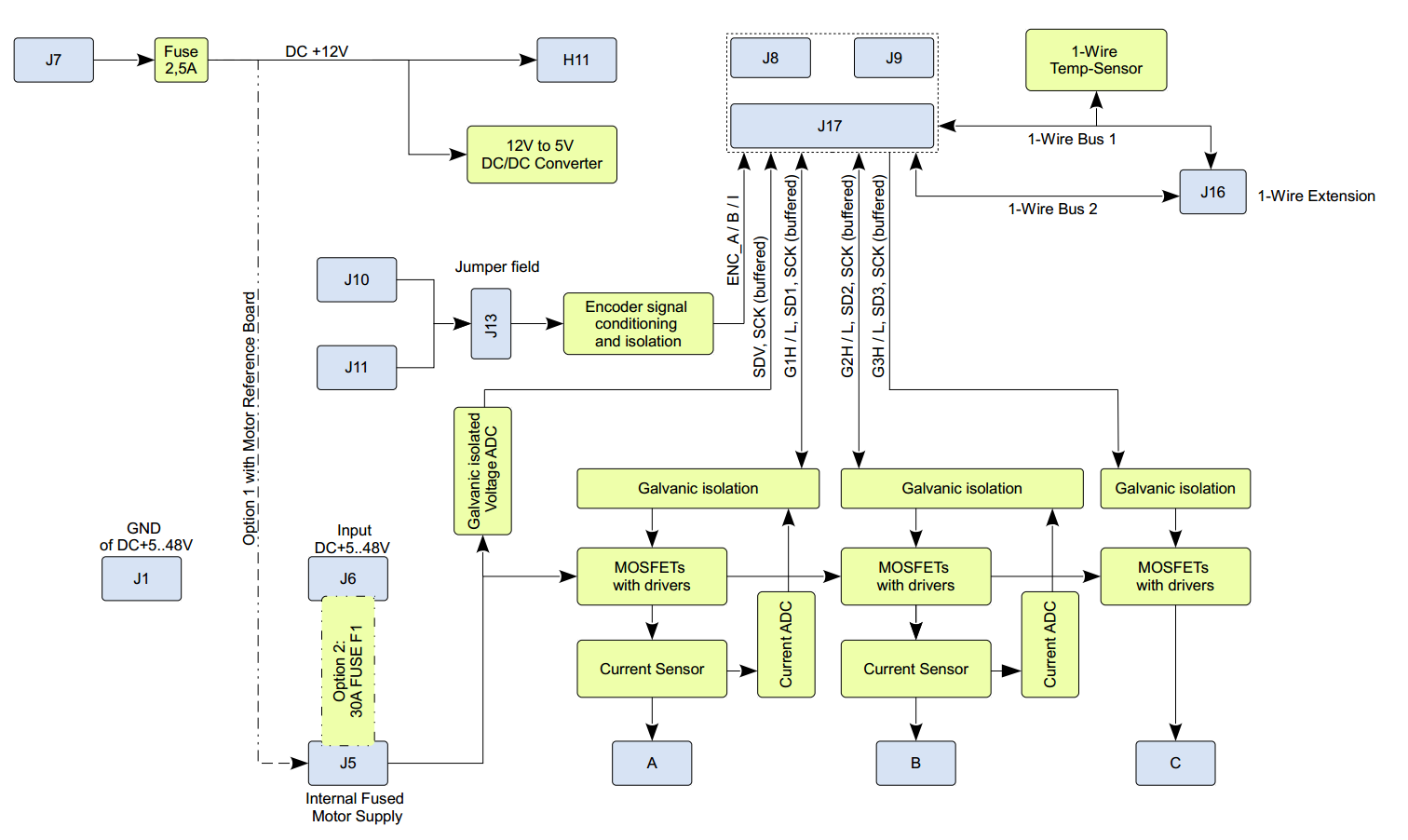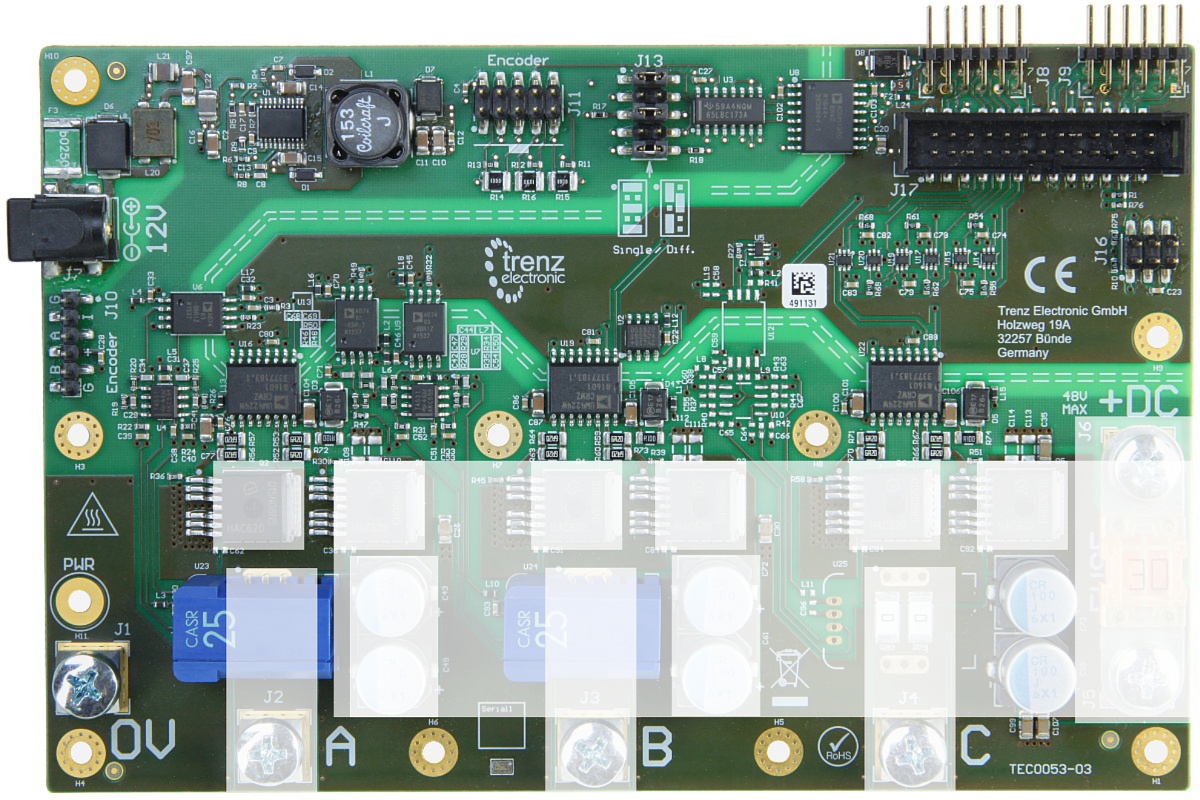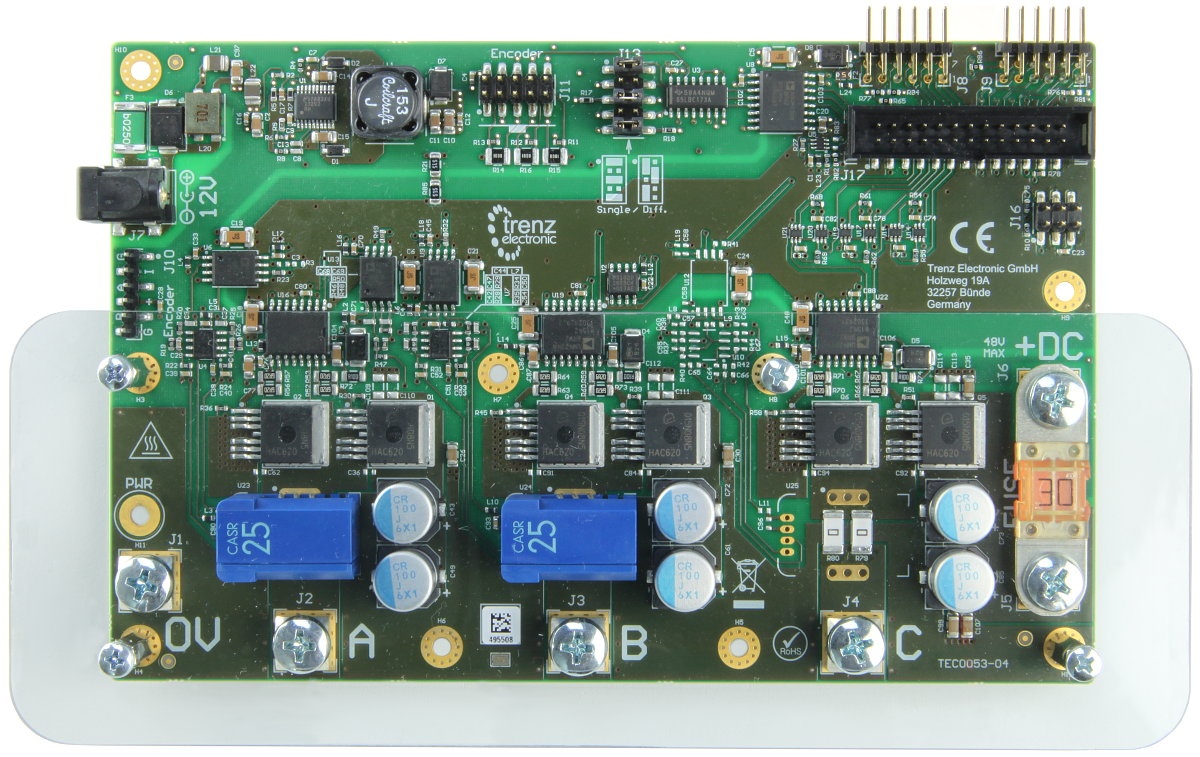Page History
...
| Scroll pdf ignore | |
|---|---|
|
Overview
| Scroll Only (inline) |
|---|
Refer to https://wiki.trenz-electronic.de/display/PD/EDPS+User+Manual for online version of this manual and additional technical documentation of the product. |
The Trenz The Electric Drive Power Stage (EDPS) Board, a Trenz Electronic TEC0053, is a Motor Driver board to be used together with the Controller Board for motor control the evaluation of Motor Control.
Key Features
- Evaluation of the Motor control Control with the a suitable controller boardController Board
- Power option up to 48V and 30A main supply current
- MOSFET power stage supporting 3-phase BLDC motors
- Current measurement on 2-phases (3 phase measurement is optional)
- On-board temperature sensor and 1-wire bus connector for additional sensors
- Encoder input capable of receiving both single ended and differential signals
Figure 1: Top view of the TEC0053 EDPS Board PCB.
EDPS Block Diagram
Figure 2: Block diagram of the EDPS boardBoard.
General Safety Instructions
- This product should be operated only by qualified electrical specialist only.
- Never leave an operating board unattended.
- There is a possible risk of burns due to the hot surfaces while operating the EDPS board. Reason for this could be an EDPS Board because of the high currents present in the motor driving outputspower stage heating the board surfaces and the board components.
- All externally connected power sources must be SELV protected (Separated or Safety Extra Low Voltage).
- All wiring and installation should be performed only with all external power sources switched OFF or disconnected.
- No wiring or mechanical setup changes should be performed while the board is operating.
- The product is rated for dry indoor , dry environment use only.
- The product is intended to be used only in horizontal position on a non-conducting and non-inflammable surface.
- The mechanical setup must ensure that the board and all of its parts are firmly fixed in place to prevent accidental or unwanted movement(e.g. sliding, falling. etc.).
Signals, Interfaces and Pins
Control Board Connectors
Figure 3: PCB connectors J8 and J9.
...
| Signal names | Connector J8 | Connector J9 | Connector J17 |
|---|---|---|---|
Digital Supply to EDPS | Pin 6, 12: +3.3V | Pin 6, 12: +3.3V Pin 5, 11: GND | Pin 5, 6, 21, 22: +3.3V Pin 1, 2, 25, 26: GND |
Motor Driver PWM Signals to EDPS High and Low Side control signals
| Pin 1: G1H - Ch.A HighSide | Pin 11: G1H - Ch.A HighSide | |
| ADC Clock Signal to EDPS | Pin 1: SCLK | Pin 23: SCLK | |
| Encoder Digital Signals from EDPS | Pin 8: ENC_A | Pin 20: ENC_A | |
| Motor Current ADC "raw" Signals from EDPS (usable with FPGA IP) | Pin 2: SDI1 - Current Ch.A | Pin 19: SDI1 - Current Ch.A | |
| Supply Voltage ADC "raw" Signal from EDPS (usable with FPGA IP) | Pin 7: SDIV - from DC_LINK | Pin 24: SDIV - from DC_LINK | |
| 1-Wire bus for temperature measurement | Pin 10: EXT1 - 1-Wire Bus 1 Pin 4: EXT2 - 1-Wire Bus 2 | Pin 4: EXT1 - 1-Wire Bus 1 | |
| Pins not connected | None | None | Pin 13, 14 |
Table 1: Description of the PCB connectors J8 and J9.
| Scroll Pagebreak |
|---|
Motor and Power Connections
There are two options available for the motor and power concept:
...
Table 2: Description of the Motor and Power connector.
On-Board Temperature Sensor
There is a on-board 1-Wire temperature sensor DS18S20Z+ from Maxim located in the middle of the PCB for optimal readings.
Addional 1-wire sensor(s) can be connected to the connector J16:
...
- Pin 1(DQ), 3 (GND),5 (+3.3V) at the same 1-wire bus as the onboard one
- Pin 2(DQ), 4 (GND),6 (+3.3V) at a separate 1-wire bus
Power and Power-On Sequence
DC 12V power supply for the Motor and Driver board
The power source must be SELV (Separated or safety extra-low voltage) protected.
...
The internal +5V digital supply is generated from this +12V supply.
DC 5...48V power supply for the Motor only
SAFETY INSTRUCTIONS:
External power supply for the motor must be SELV (Separated or safety extra-low voltage) protected.
- only allowed to be used for electrical specialist for the used electrical voltage and power conditions
- only allowed to be used under electrical laboratory conditions
- only allowed to be used in horizontal position on a non-conducting and non-inflammable surface
- only allowed to be used with a wiring, which fulfills the current rating for the maximum possible currents.
- only allowed to be used with a suitable current limiting circuit such that the maximum continuous current does not exceed 30A as follows:
- The delivered fuse "Littelfuse Type 142.5631.5302" must be used as current limiter between connectors J5 and J6.
- To limit the current for smaller motor loads an ADDITIONALL appropriate current limiter can be used e.g. a current limited power source or a fuse integrated in the wiring.
- only allowed to be used with appropriate connectors at the M5 screw connectors, which means M5 cable lugs must be used and fastened according to technical standards.
only allowed to be used, if the
"Drive Boadhigh current
signals"parts conducting up to 30A nominal, are covered by isolating, mechanically stable, non-inflammable (UL V-1 or better) material
. The
"Drive Boardhigh current
signals"parts are shown on the following picture:
Figure 5: The high current parts on the EDPS Board, the motor outputs A, B, C
...
, fuse F1 Connectors J5
...
, J6 and further internal connections
...
Figure 5: High-current parts of the TEC0053, are marked white.
| Warning |
|---|
| It is mandatory to use the delivered isolating cover of the PCB made of plexiglass as a minimum protection. Use holes H1, H9, H3 and H4 with the delivered 10mm spacers when mounting. |
Figure 6: Top view of the EDPS Board with isolating transparent plexiglass cover attached.
...
Figure 7: Side view of the EDPS Board with isolating plexiglass cover.
...
The cable lugs used should be isolated in the outer border area of the Drive EDPS Board.
Make sure that the Isolating PCB Cover is overlapping the conducting material by a minimum of 20 mm.
Initial Operation
Prepare the EDPS board as follows:
- In the case of low-powered motors and/or low-powered power supply it is recommended to use additional current limiter circuit or additional fuse.
- Mount the delivered 30A fuse to the connectors J5 and J6 with the delivered M5 screws.
- Use at most 3m long cable with lugs to connect the positive terminal of the motor power supply to J6 (DC +5..48V) and the negative terminal to J1 (0V).
- Use at most 3m long cable to connect the three motor phases to J2 (A), J3 (B) and J4 (C).
- Connect 12V power supply to J7 (12V). In the case motor power supply voltage is 12V as well, one power supply can be used.
- Optional: Connect the encoder to J10 or J11 and set jumper field J13 according to the signal specification either to differential or to single ended configuration.
Power-On Sequence
Any power sequence of the three supply sources is allowed:
- +3V3 Supply from the Control Board, generated by Control Board supply
- +12V and
- Optional +5..48V Motor Supply
...
Adapter Board TEC0060
For easy connection of the reference Reference Motor and Encoder to the EDPS Board a special Motor Adapter Board TEC0060 is included in the EDDP Kit.
Figure 8: Reference Motor Adapter Board TEC0060 with the Reference Motor and Plastic DEMO load attached.
Reference Motor
The reference motor is Reference Motor and Encoder are manufactured by Anaheim Automation. The order code for the motor with the encoder already mounted is BLWR111D-24V-10000-1000SI. Please note that the encoder is not available separately. The nominal motor voltage is DC 24V, however, only 12V is supplied by the Reference Motor Board, which results in reduced performance.
Refer to the BLWR11 - Brushless DC Motors and Single-Ended Encoder with Index Channel for more information.
Technical Specifications
Absolute Maximum Ratings
| Parameter | Min | Max | Units | Notes |
|---|---|---|---|---|
DC +12V supply | 0 | 15 | V | |
| DC +5..48V supply | 0 | 50V | V | |
| DC +3V3 supply | -0.5 | 6 | V | |
| PWM Input | -0.5 | 6 | V | |
| ADC Digital Input | -0.5 | 3.8 | V | DC +3V3 = Assuming digital power supply voltage is at 3.3V |
| Encoder Input | -10 | 15 | V |
Table 3: Absolute maximum ratings.
Recommended Operating Conditions
| Parameter | Min | Max | Units |
|---|---|---|---|
DC +12V supply | 11.5 | 12.5 | V |
| DC +5..48V supply | 5 | 48 | V |
| DC +3V3 supply | 3.0 | 3.6 | V |
| PWM Input | 0 | DC +3V3 supply | V |
| ADC Digital Input | 0 | DC +3V3 supply | V |
| Encoder Input | -7 | 12 | V |
Table 4: Recommended oprating conditions.
| Scroll Pagebreak |
|---|
Electrical characteristics
DC +3V3 supply = 3.3V
| Parameter | Min | Max | Units | Notes |
|---|---|---|---|---|
| PWM Input Logic High Level | 2.2 | V | ||
| PWM Input Logic Low Level | 0.8 | V | ||
| ADC Digital Input Logic High Level | 2.7 | V | ||
| ADC Digital Input Logic Low Level | 0.6 | V | ||
| ADC Digital Output Logic High Level | 3.2 | 3.3 | V | Io=-200μA |
| ADC Digital Output Logic Low Level | 0 | 0.4 | V | Io=+200μA |
| Encoder Input Logic High Level (Differential) | -0.2 | V | ||
| Encoder Input Logic Low Level (Differential) | -0.01 | V | ||
| Encoder Input Logic High Level (Single ended) | 2 | V | ||
| Encoder Input Logic Low Level (Single ended) | 0.6 | V |
Table 5: Electrical characteristics.
Physical Dimensions
Board size: 100 mm × 166 mm. Please download the assembly diagram for the exact numbers.
PCB thickness: 1.75 mm +/-10%
Highest part on PCB: approximately 17 mm. Please download the step model for the exact numbers.
All dimensions are shown in millimeters.
...
Figure 9: Physical Dimensions of the TEC0053 boardEDPS Board.
Operating Temperature Ranges
0°C - 70°C, cooling might be required depending on environment and airflow.
References
All resource links for other relevant documents and websites are available from Trenz EDDP Web Hub:
Revision History
Hardware Revision History
| Date | Revision | Notes | PCN Link | Documentation Link |
|---|---|---|---|---|
| 2017-08-14 | 04 | Initial public revision |
...
Hardware revision number is printed on the PCB board in the bottom right corner.
Document Change History
Date | Revision | Authors | Description | ||||||||
|---|---|---|---|---|---|---|---|---|---|---|---|
| Jan Kumann | General formatting changes and small corrections. | |||||||||
| 2017-08-14 | v.10 | Antti Lukats, Andrei Errapart | Initial version. |
...


